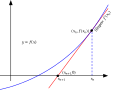Newton's method
Newton's Method, also known as the Newton-Raphson Method, is a powerful technique in numerical analysis for finding successively better approximations to the roots (or zeroes) of a real-valued function. The method is named after Isaac Newton and Joseph Raphson, who are credited with its development. It is widely used in scientific and engineering computations and is one of the most well-known algorithms for root finding.
Overview
Newton's Method starts with an initial guess for a root of the function and iteratively refines this guess by applying a specific formula. The method assumes that the function in question is differentiable, and it uses the derivative of the function at the approximation to inform the next guess. The basic idea is to approximate the function by a tangent line and then use the zero of this linear function as the next approximation to the root.
Formula
Given a function f and its derivative f' , the formula for Newton's Method is:
\[ x_{n+1} = x_n - \frac{f(x_n)}{f'(x_n)} \]
where:
- \(x_n\) is the current approximation,
- \(x_{n+1}\) is the next approximation,
- \(f(x_n)\) is the value of the function at \(x_n\), and
- \(f'(x_n)\) is the value of the derivative of the function at \(x_n\).
Convergence
The convergence of Newton's Method depends on several factors including the nature of the function and the initial guess. Under good conditions, the method converges very quickly, and the error decreases quadratically. However, there are situations where Newton's Method may fail to converge, or may converge to a root different from the intended one if the initial guess is not close enough to the actual root.
Applications
Newton's Method is used in a wide range of applications from optimization problems to solving equations in physics and engineering. It is particularly useful in scenarios where the function in question is complex and other methods of finding roots are inefficient or fail to converge.
Example
Consider the function \(f(x) = x^2 - 2\) which has roots at \(\sqrt{2}\) and \(-\sqrt{2}\). Using Newton's Method and an initial guess of 1, the sequence of approximations rapidly converges to \(\sqrt{2}\).
Limitations
While Newton's Method is powerful, it has limitations. It requires the calculation of the derivative of the function, which may not always be easy or possible. Additionally, the method can fail if the derivative is zero at the approximation, and it may not converge if the initial guess is not sufficiently close to the true root.
See Also
This article is a mathematics-related stub. You can help WikiMD by expanding it!
Transform your life with W8MD's budget GLP-1 injections from $125.
W8MD offers a medical weight loss program to lose weight in Philadelphia. Our physician-supervised medical weight loss provides:
- Most insurances accepted or discounted self-pay rates. We will obtain insurance prior authorizations if needed.
- Generic GLP1 weight loss injections from $125 for the starting dose.
- Also offer prescription weight loss medications including Phentermine, Qsymia, Diethylpropion, Contrave etc.
NYC weight loss doctor appointments
Start your NYC weight loss journey today at our NYC medical weight loss and Philadelphia medical weight loss clinics.
- Call 718-946-5500 to lose weight in NYC or for medical weight loss in Philadelphia 215-676-2334.
- Tags:NYC medical weight loss, Philadelphia lose weight Zepbound NYC, Budget GLP1 weight loss injections, Wegovy Philadelphia, Wegovy NYC, Philadelphia medical weight loss, Brookly weight loss and Wegovy NYC
|
WikiMD's Wellness Encyclopedia |
| Let Food Be Thy Medicine Medicine Thy Food - Hippocrates |
Medical Disclaimer: WikiMD is not a substitute for professional medical advice. The information on WikiMD is provided as an information resource only, may be incorrect, outdated or misleading, and is not to be used or relied on for any diagnostic or treatment purposes. Please consult your health care provider before making any healthcare decisions or for guidance about a specific medical condition. WikiMD expressly disclaims responsibility, and shall have no liability, for any damages, loss, injury, or liability whatsoever suffered as a result of your reliance on the information contained in this site. By visiting this site you agree to the foregoing terms and conditions, which may from time to time be changed or supplemented by WikiMD. If you do not agree to the foregoing terms and conditions, you should not enter or use this site. See full disclaimer.
Credits:Most images are courtesy of Wikimedia commons, and templates, categories Wikipedia, licensed under CC BY SA or similar.
Contributors: Prab R. Tumpati, MD





